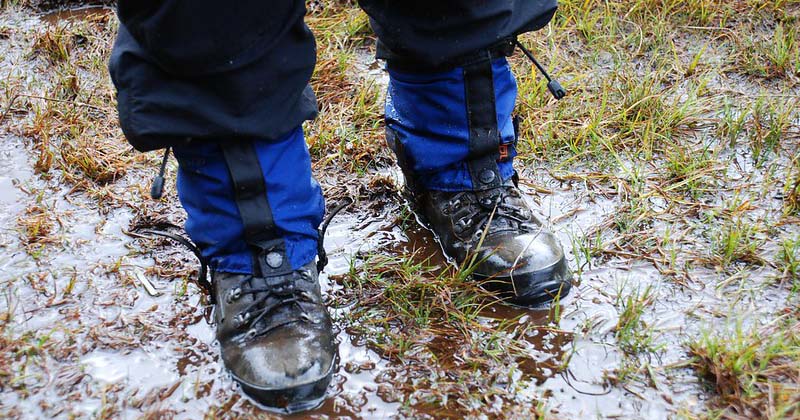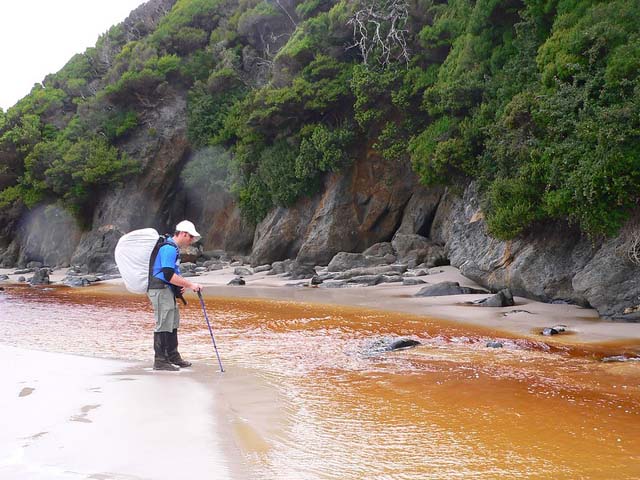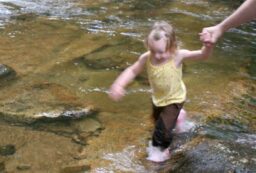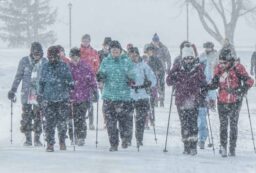You can wear waterproof jackets and pants to keep your body dry, but keeping your feet dry while hiking in the rain is much trickier. And, once your feet get wet, you’re much more likely to get blisters and other damage.
Here’s what you can do to keep your feet dry during rainy hikes, as well as when to admit defeat and just protect your feet from wetness instead.
How to Keep Your Feet Dry
1. Waterproof Your Boots
Contrary to what manufacturers imply, there’s no such thing as completely waterproof boots. You actually wouldn’t want to wear a completely waterproof boot: It wouldn’t be breathable and you’re feet would get sweaty (and thus wet from the inside instead of out!).
However, there are some boots which strike a good balance between breathability and waterproofness. You’ve got three main choices:
Leather with a Water-Resistant Coating
While a pain to break in, leather is naturally water-resistant and very durable. Many leather hiking boots are now treated with a water-resistant coating to prevent them from absorbing water. You still won’t want to submerge them in water (they take forever to dry!), but they’ll handle a light-to-moderate rain well enough.
You can also waterproof your existing leather boots. There are products on the market like Nikwax Leather Waterproofing wax and Otter Boot Wax that do a great job.
Waterproof Membranes (Gore-Tex/eVent)
In this case, a membrane is added inside the boot liner. The membrane holes are small enough that water can’t get in but water vapor from your sweaty feet can still exit. In this sense, Gore-Tex or eVent membrane boots actually are waterproof and fairly breathable. They also dry very quickly which makes them good for backpacking or overnight hikes.
However, they aren’t going to keep your feet dry in a major downpour. There are seams in the boots where water can leak in.
They are particularly terrible if submerged, such as during stream crossings: the waterproof membrane means that the water has no way of exiting once it enters!
DIY Boot Waterproofing
Don’t want to pay for a new pair of waterproof boots? You can use any of these DIY methods to waterproof your boots.
For Leather Boots:
- Oil: Put a small amount on a rag and rub over your boots. Don’t soak the boot in it. Mineral oil, mink oil, and neatsfoot oil are popular options.
- Wax: Heat up the wax a bit (it should be soft and not liquid) and rub it onto your boots. Leave it to “cure” for at least one day before hiking in the boots.
- Lanolin: Let it warm up to the point that it becomes a cream. Then apply it to a soft cloth and rub it all over your boot.
For Synthetic Boots:
You’ll have a harder time finding true DIY methods for waterproofing synthetic or fabric boots. Store-bought products work best and aren’t that expensive.
- Kiwi Boot Waterproofing Sprays: This brand makes a lot of great spray-on coatings for synthetic materials.
- Scotchguard Fabric Spray: A lot of people swear by this. Just spray it onto your boots.
- Nikwax Fabric and Leather Proof: This can work on synthetic or leather boots.
- Gear Aid ReviveX Nubuck Suede and Fabric Waterproofing: Great for boots with a Gore-Tex or eVent lining
2. Wear Gaiters
Gaiters are covers that go over your lower leg and ankles. Sometimes they extend down over your boot laces too.
Normally rain would pool down over these areas. Gaiters will keep rain from flowing into your boots. They also keep the padded ankle area of your boots from getting wet (which usually absorbs rain like a sponge).
If you are wearing gaiters to keep your feet dry, then you’ll need to choose gaiters that have:
- Multi-layer construction (Water-resistant exterior and waterproof membrane lining)
- Velcro or storm flap to keep water out of closure
- Lace hook
- Adjustable stirrup strap
Outdoor Research makes some of the best waterproof gaiters for hiking. You can find them or here on Amazon![]()
Wear gaiters under or over rain pants?
Gaiters should be worn under rain pants. If you were to wear them over your rain pants, the rain would seep in through the gaiter top closure and drip down into your boots.
3. Use a Waterproof Sock or Membrane
There are a lot of companies now that make waterproof seamless socks. They actually do a great job of keeping your feet dry, even when completely submerged during stream crossings. Randy Sun is one of the most popular brands (available here on Amazon).
The tradeoff is that waterproof socks are not breathable. Despite what the manufacturers claim, your feet will end up getting sweaty and thus wet from the inside.
How to wear waterproof socks:
Waterproof socks should be worn over a pair of hiking socks. That means you’ll need to buy a size or two larger than you normally wear. Never wear waterproof socks directly against your skin.
4. Accept that Your Feet Will Get Wet
The above waterproofing methods only work to a certain point. And the benefits are often outweighed by the lack of breathability. Thus, many hikers admit defeat and accept the fact that their feet will get wet when hiking.
That doesn’t mean you have to be miserable while hiking. Rather, it means that you’ve got to protect your feet from damage caused by maceration or immersion.
Protecting Your Wet Feet from Damage
Once you’ve accept that your feet will get wet while hiking, the issue then becomes one of protecting your feet. Wet feet absorb water and become very sensitive. They are more likely to blister. Once they dry out, they can end up cracking and bleeding. Or you might end up with even more serious damage like trench foot.
Instead of trying to keep their feet dry, smart hikers instead take steps to minimize the damage caused by wet feet. Here are some ways to do that:
1. Wear Two Pairs of Hiking Socks
As I talk about in this post about why to wear two pairs of socks, a liner sock is great at preventing blisters.
The liner sock (made out of a slippery material like silk) helps wick moisture away from your feet while also preventing friction. The second sock is your insulating sock.
2. Choose Quality Hiking Socks
You’ve got two material choices when it comes to socks for wet-weather hiking: Merino and synthetics.
Merino wool:
- Wicks moisture away
- Comfortable in warm or cool weather
- Tends to dry slowly
- Holds a lot of water
- Not very durable
Synthetics:
- Dry faster
- More affordable
- Durable
- Don’t feel very good on the skin
- Smell terrible!
- Not very insulating when wet
The best choice?
In most cases, you are best with a blend. Look for a sock which is approximately 65% Merino and 35% synthetic. This will give you the benefits of Merino with more durability.
3. Apply Balm to Your Feet
Balm does wonders at keeping too much moisture from getting into your skin. It also protects it from moisture damage.
You’ll need to apply balm right before your hike. Ideally, you also reapply the balm whenever you take a longer pause.
Two recommended foot balms for hikers include:
4. Choose Trail Runners Instead of Boots
Trail runners are becoming much more popular with hikers, especially thru-hikers. While they don’t provide nearly as much protection as boots (especially against snakes and twisted ankles), they are much more comfortable to wear when wet. The flexible fabric means that they won’t damage your feet as much. They also dry much faster.
If you are going to be doing a lot of stream crossings (and don’t want to take off your boots each time), then trail runners are the way to go.
5. Take Off Shoes and Socks during Longer Breaks
Yes, this is a pain but it will help your feet dry out a bit so they are less likely to get damaged by the wetness. However, it really does suck to put wet socks and shoes back on!
6. Put on Waterproof Socks Once You’re At Camp
I always bring a lightweight pair of sandals to wear at camp on my backpacking trips. But, if it’s really wet outside, I have to stay in my boots.
A solution is to bring a pair of waterproof socks. The waterproof socks protect your feet from the wet boots. Since you are done hiking for the day, the lack of breathability isn’t such an issue.
Any other tips you can add about keeping your feet dry and comfortable while hiking? Let us know in the comments!
Some resources for this article:
https://www.caminodesantiago.me/community/threads/shoe-and-foot-strategies-when-walking-while-it-is-raining-and-wet.54565/
https://www.oregonhikers.org/forum/viewtopic.php?t=23446&start=10
https://www.reddit.com/r/Ultralight/comments/3tib5w/darn_tough_socks_cause_wet_feet/
https://backpackinglight.com/forums/topic/44157/
https://backpackinglight.com/forums/topic/79301/
https://backpackinglight.com/forums/topic/79301/
https://besthiking.net/hiking-boots-vs-hiking-shoes-vs-trail-runners/
Image credits:
“Wet boots” (CC BY-NC-ND 2.0) by Kathrin Marks
“Rod river crossing” (CC BY-NC-ND 2.0) by In Memoriam: VernsPics














1 Comment
Isaac
May 5, 2023 at 6:20 amExcellent post! Thanks for all the tips!